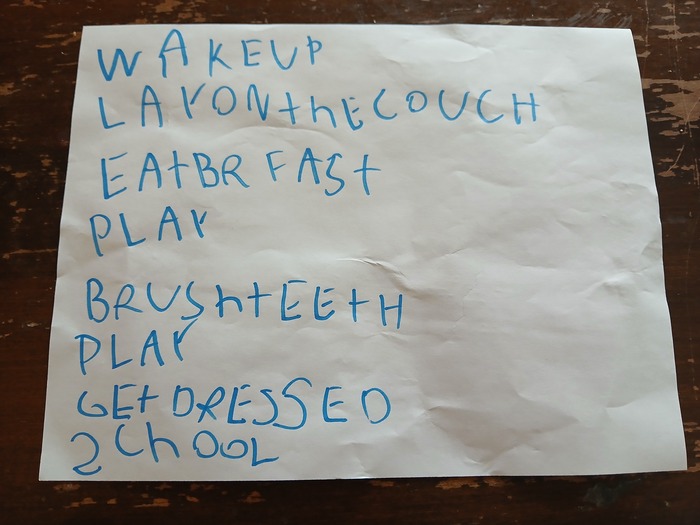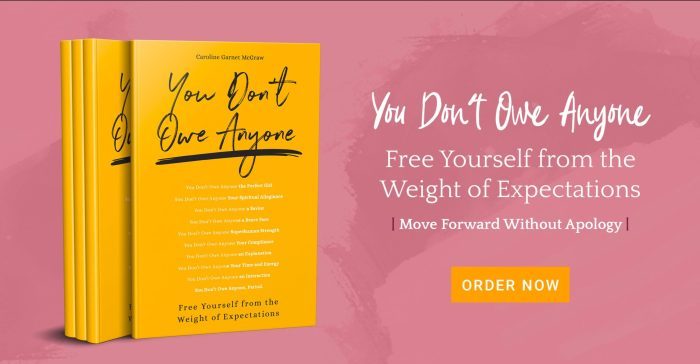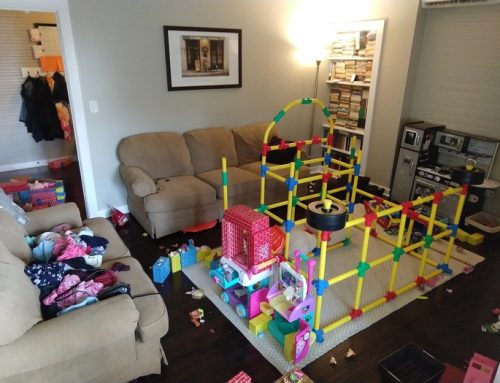Once upon a time there was a woman I’ll call Julia, who did something brave. Julia was a loving mom of two, and she went to see one of her children perform at a holiday concert. As the recorders squealed and the children sang, she noticed something important.
She was very uncomfortable in that crowded room, with its hard chairs and general cacophony. In years past, Julia would have ignored this discomfort. But this year – after decades of living with Human Giver Syndrome – things are different for Julia.
In Pursue Your Path coaching, Julia has been practicing knowing what she knows and feeling what she feels. She’s been learning how to taking care of her own needs, even as she shows up with love for her kids.
So this year, after her child’s class completed their performance … Julia did something radical. She told the truth about how she was feeling. She told her family that she wanted to leave. And wouldn’t you know it, others felt the same. So they all left together.
“Every other year I would have made myself miserable and stayed,” she told me. But not this year. Not after the inner work she’s done to build her courage. This year, she set herself free. When she told me, I threw up my arms and cheered.
And if you think this seemingly ordinary moment isn’t a big deal, then you’re in the wrong place. I’m writing this for those of us with Human Giver Syndrome, for whom prioritizing one’s own feelings and needs constitutes a miracle.
But let’s back up a step and define our terms, shall we?
What is Human Giver Syndrome?
Let’s give credit where it’s due: Kate Manne created the term “Human Giver Syndrome” as part of her 2017 book Down Girl: The Logic of Misogyny.
Like many others, though, I first learned about the term through the work of Emily and Amelia Nagoski in their 2019 book Burnout: The Secret to Unlocking the Stress Cycle.
What is Human Giver Syndrome? I’ve heard the Nagoskis describe it as follows:
“A duty [primarily for those socialized as women] … to give everything they have — their time, their attention, their patience, their love, their rest, their bodies, their hopes and dreams, their very lives sometimes, sacrificed on the altar of other humans’ comfort and convenience.”
The term is tied to Adam Grant’s concept of the Sacrificial or Selfless Giver, as described in his 2013 book Give and Take: Why Helping Others Drives Our Success.
(Apparently there was something in the water in the early 2010s; it was time for this phenomenon to go public!)
In Give and Take, Grant distinguishes between two types of Givers. Here’s how I explained it in my 2016 TEDx talk:
“There are two different types of Givers. The first and most successful type gives while guarding personal limits. This type sets healthy boundaries, holding self-interest and other-interest simultaneously. For them, it’s not self or others; it’s self and others.
By contrast, the second and least-successful type gives to the point of exhaustion. They have trouble saying no to anyone. As a result, they are always, always tired.
I know, because I used to be one of them. I used to think that if I didn’t give away every ounce of energy to others, I was being selfish. Often we equate being a Giver solely with this type, with being depleted.”
Watch the five minute talk here:
Human giver syndrome symptoms
Which brings us to our list of Human giver syndrome symptoms. Do you see yourself in this list?
- Feeling deeply depleted and burnt out
- Feeling increasingly frustrated and tense with the people around you
- Secretly wishing you could check into the hospital (or go to rehab, or check out of your own life with some “legitimate” excuse)
- Taking pride in being the responsible one – while wishing that it wasn’t “all on you” (often with history as a parentified daughter)
- Consistently taking on really big projects, while snapping when being asked about little tasks
- Masking your true thoughts and feelings
- Feeling embarrassed to be seen as needing help
- Believing your worth is in being able to help
- Over-filling your time based upon internalized expectations of how a good person “should” act
- Having a strong desire to be good, and to be seen as good
- Having a history with “exploding doormat” behavior – overgiving and sacrificing yourself right up until a huge blowup that other people often don’t see coming
I love how David Seabury explains that last point in his 1937 classic The Art of Selfishness:
“Everything and everybody has a saturation point. This means you. The time will come when you can stand no more from the people and things who fill you with fury … If such a saturation is inevitable, is it not better to change now, before the explosion?”
Can human giver syndrome be treated?
Emphatically yes. I’m going to address how to treat human giver syndrome on all four levels of self: body, mind, heart, and spirit.
Healing Human Giver Syndrome on the Physical Level
On the physical level, here’s your top priority: Rest. We’ll get into how to take more off your plate long-term in a minute, but if you’ve had Human Giver Syndrome for basically your entire life and you’re feeling exhausted, you need some relief.
Think short-term. As in, how soon can I lie down and rest? Sleep-rest is great, yes, but awake-rest is also important. A micro-rest is fine to start, even a few minutes can help to take the pressure off. Let me show you how this looks, with a visual from our then-five-year-old’s first to-do lists.

Personally, I was thrilled to see “lay on the couch” included in her list. It’s my favorite part of the morning: the kids stumble out of their beds, and we all connect on the couch and cuddle before breakfast.
As a coach for recovering perfectionists, I see a lot of to-do lists. Rarely do “rest” or “lay on the couch” ever appear on those lists. And yet we wonder why we’re so stressed!
We’ve been trained out of our natural inclinations – to rest, to play, to connect. We need our five-year-olds to remind us: these things matter.
Today, here’s my challenge to you: Channel your inner five-year-old and put “lay on the couch” on your to-do list. Put your feet up, even for a few minutes.
Bonus points if you take a nap. Super bonus points if you take an entire day to rest, only doing something if it feels like play, not work.
It’s not really doing nothing. It’s taking care of a precious person. It’s taking care of YOU.
Oh, and quick heads-up: please be careful not to immediately add MORE to your plate once you feel a bit better.
This is a sneaky thing that we do, as recovering perfectionists and over-givers – it’s as though the second we have any “extra” energy, we assume that we must spend it by giving some more.
Here’s my personal experience with this: When I came home from a long-awaited trip to Scotland with close friends this past summer, my therapist told me she’d made a note to check in with me about whether I was taking on too much after the trip.
You see, she’d noticed a pattern: As soon as I recharged my batteries, I piled on more projects and responsibilities.
Do you ever do that, dear reader? Ever resolve to take care of yourself, shoring up your reserves through rest or play … only to immediately take on tons more work to “atone” for it? Me too!
False guilt and self-denial trick us into getting back on the hamster wheel. Often there’s a feeling that we don’t deserve the newfound good energy.

When I mentioned this pattern to my husband Jonathan, he told me that to extend the life of an electric car battery, you charge it slowly. Slower charging extends battery life, whereas fast charging degrades battery life. Recharging slowly is better in the long run.
“Wait, is this a metaphor?” I laughed.
Of course it was. I’d been doing the fast-charge, fast-burn cycle for years, and he knew it. But thanks to both the healing power of Scotland and the magic of metaphors, this summer I did something different. While I did start burning through my batteries quickly after the overseas trip, I stopped myself sooner.
This is an underrated victory: Noticing an unhelpful pattern, then stopping it before it spirals. And I invite you to do this as you rest. Notice the impulse to spring into action and start giving more. Just watch it, instead of automatically obeying it.
Healing Human Giver Syndrome on the Mental Level
Now that you’ve had a breather, it’s time to question the beliefs that have been driving you to give until you drop. Your primary task here is to recognize that if you truly want to give more to others, you actually need to dedicate more time and energy to your own well-being.
It sounds paradoxical, but it’s true: for recovering Human Givers like us, the most selfless thing we can do is take better care of ourselves.
Listen as Adam Grant explains why this is true:
“… If you look at 30-plus years of data on this, the people who are the most selfless, the most altruistic, actually give less than the people who balance concern for others with concern for self ….
If you are selfless to the point of self-sacrifice, at some point you run out of energy and resources … to be able to able to contribute to others.
Whereas people who are able to work toward their own goals, or at least keep their own interests in the rear view mirror when they’re helping others, are able to sustain their energy and their resources. And that allows them to give much more over time.”
Taking care of yourself first is actually great for your personal relationships too. To quote David Seabury and The Art of Selfishness once more:
“Have you ever noticed this mysterious contradiction: that those who toil unmercifully for others lose the love of those for whom they sacrifice? It is not only a fact but a fulfillment of a law. People love us for what we are. As we disappear under the burdens they put on us, they unconsciously blame us for the loss of our charm which the burdens create.”
Healing Human Giver Syndrome on the Emotional Level
When we’re chronically overwhelmed and overextended – when we’re operating from Human Giver Syndrome – there’s a part of us that’s unwilling to live in reality. To say, “This is what’s not working for me,” or, “This is my limit,” or, “This is enough.”
Why don’t we say these things? Why don’t we live in reality? Well, because doing so feels unsafe!
My favorite coach, Dr. Martha Beck, taught me that we leave integrity because of two powerful forces: socialization (how we’ve been taught and trained to behave in relationships) and trauma (how we’ve been hurt).
When we let trauma and socialization dictate our choices, we tend to end up in chronic overwhelm and overextending. We stay in a fantasy of how things “should” be, rather than seeing them as they are.
Real change begins when we come into integrity. When we leave the superwoman fantasy behind and tell the truth of our own experience.
But this is tricky, because again, when we’re socialized to believe that telling a certain truth is wrong – or we’re hurt for going anywhere near the topic – we naturally learn to avoid that truth.
All to say – if you’ve been overextending yourself, there’s a way out. But it’s going to require you to examine the underlying core issues. It’s going to require you to get in touch with parts of yourself that you’ve disowned and pushed aside.
Here’s one practical way to do this, excerpted from my first book, You Don’t Owe Anyone: Free Yourself from the Weight of Expectations.
Do Free Writing
This is a powerful exercise anytime, but particularly so in times of intense emotion. (I’ve encountered variations of this tool in several places; it’s similar to Morning Pages in Julia Cameron’s The Artist’s Way, and the staff at The Clearing also teach a form of this process.)
The exercise is simple: Get a pen and a pile of blank paper. Set a timer and write for fifteen minutes. During this time, keep your hand moving continually; write anything and everything that comes up for you.
Nothing is off-limits; as long as your hand is moving and you’re writing, you’re doing the exercise correctly.
Let everything out onto the page; hold nothing back. Say exactly what you think and how you feel. Tell the truth of your own experience. Write what is real for you, here, now, today.
When your time is up, do not reread your words. Instead, destroy the paper completely. Personally, I love to burn the paper, but since I’m often in places where it’s not safe to do so, I’ll soak the paper in water and then tear up the sodden pieces.
Knowing that I will destroy the paper as soon as I’m done writing gives me a sense of freedom to be real and raw. Try it and see what happens when you give yourself the gift of this releasing.
PS – If you’re feeling somewhat shocked by what you wrote, that’s actually a good sign that you’re breaking free of what Julia Cameron calls the “virtue trap.” To quote her classic book The Artist’s Way:
“Virtuous to a fault, these trapped creatives have destroyed the true self, the self that didn’t meet with much approval as a child. The self who heard repeatedly, ‘Don’t be selfish!’ The true self is a disturbing character, healthy and occasionally anarchistic, who knows how to play, how to say no to others and yes to itself.”
So if you’ve gotten in touch with a somewhat “disturbing character” who knows how to play and say yes to itself … you’re on the right track. But what do you do when saying yes to yourself seems like it leads you away from others you love? Or is that a false choice?
Let’s explore that in one more story.
Healing Human Giver Syndrome on the Spiritual Level
“Do you care about yourself more than you care about me?”
This is the question my newly-six-year old kid asked me first thing this morning. You know, just an easy, softball question before breakfast!
I asked why she wanted to know. She shrugged; she wasn’t upset, just curious. So I took a deep breath and probably said way too many words as I thought it through. For you, dear reader, I will sum it up.
I told her that I love her and her sister to infinity. That I will do whatever it takes to take care of them, to be a great mom to them.
And, in order for me to do that, I need to love myself first. To be a good mom, I need to actually have a self to show up with. Otherwise, they just get a shaky, dim shadow. The goal isn’t self-sacrifice. It’s wholeness for all of us.
If I want them to grow up feeling joyful and free, I, myself, need to model joy and freedom. If I want them to grow up knowing that they’re free to pursue their creative dreams and travel and have adventures, then it’s on me to do those things! Even if that disappoints them now and then.
Of course, the kiddos initially didn’t want me to go to Scotland for a week – it was the longest we’d ever been apart. But I went, it was amazing, and now we’re planning another trip for the whole family. Joy is multiplicative!
That way, I’m not putting pressure on them to be my happiness. I’m building my own happiness, and supporting them as they build theirs.

Happy and playful after a surprise swim in a loch, June 2025.
Then something dawned on me: “Honey, if I love myself first in my heart, then of course I am loving you, because you are in my heart. That’s just how it is.”
(Even if one day I needed to put my life on the line to protect my kids, that wouldn’t be self-sacrifice to me. It would just be me being true to myself, true to the love in my heart.
That’s why I put my work aside yesterday, when my youngest was sick. Instead of writing, I took care of her. It felt true. And today, it feels true to write to you. What feels true is always changing.)
I tried to explain this to my eldest, and mostly failed. But I was glad she had asked, glad we were together on the couch, with the morning light coming in and glinting on the golden strands in her hair.
A Practical Challenge
Dear reader, if this is tough for you – I get it. For hardworking, giving people like us, the toughest challenge is to slow down and rest. To not add “just one more thing” to the plate. It’s a pattern you learned long ago, but rest assured, you can unlearn it.
Here’s a doable challenge for you: First, notice when you are doing or giving more than your share. Next, pull back just a little. Give a little bit less, receive a little bit more.
For example: Recently I received a long message from a member of my extended family, which concluded with, “Do you have any time to [gather the family to] Zoom sometime?”
Here’s what I normally would have done upon receiving that text:
- Sprung into action; spoken to my children and spouse about whether they wanted to connect
- Looked at our calendar for a time (while feeling my frustration mounting, because it was yet another thing for me to take on)
- Replied to the person to coordinate with their schedule
- Set an alarm to remind myself of the call
- Sent a Zoom link 5 minutes prior to the time
- Hosted the Zoom meeting
- Helped two small children to effectively communicate with several adults long-distance
- Concluded the call and wanted to collapse.
And while we do in fact have a Zoom meeting on the schedule, here’s what I did differently this time. This time I weighed my options. I considered saying no entirely.
Then I decided that while I was willing to keep the door open for connection, I was not willing to go into Human Giver Syndrome.
So I replied to the text with, “Hope you’re having a great time [on vacation]; yes the kids are keen to Zoom.”
And I left it at that. I didn’t propose a time. I didn’t take the lead on something that wasn’t mine to lead. I just replied to the question that was asked. It was a little uncomfortable, in the way growth often is.
A few days later, the family member proposed a time, and we set up the call from there. It was just one small change, but it made a big difference in how I felt.
Your Next Step to Freedom
If you’ve been so busy caring for others … if you’re struggling to shift your mindset to focus more time and energy on yourself … here’s how you make a change. Here’s how you live with purpose, prioritize your needs, and break free from time scarcity.
Enter your email address below to receive the Sacred Circle Exercise and free up at least 260 hours of your precious time this year.
Free Up Time to Pursue Your Purpose with the Sacred Circle exercise!
Already subscribed and want real-world stories and practical tools to help you recover from Human Giver Syndrome?
Get your copy of You Don’t Owe Anyone.
Share This:
Comments
Related Posts



